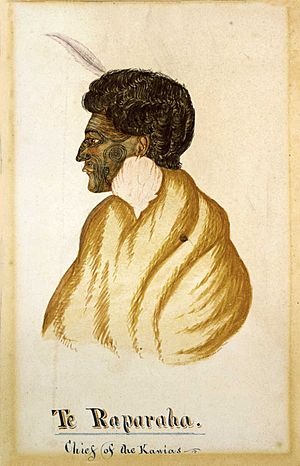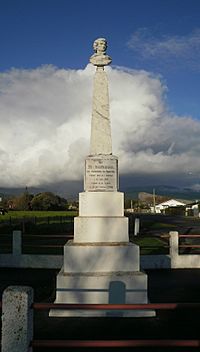Te Rauparaha facts for kids
Quick facts for kids
Te Rauparaha
|
|
|---|---|

Sketch of Te Rauparaha
|
|
| Born | c.1768 Probably Kāwhia, Waikato, New Zealand |
| Died | 27 November 1849 (age 80–81) Ōtaki, Te Upoko o te Ika, New Zealand |
| Buried | |
| Allegiance | Ngāti Toa |
| Years of service | 1819–1848 |
| Battles/wars | |
Te Rauparaha (born around 1768 – died 27 November 1849) was a powerful Māori leader and war chief, known as a rangatira. He belonged to the Ngāti Toa tribe. Te Rauparaha played a big part in the Musket Wars, a time of many battles between Māori tribes. Because of his skills as a leader, he was sometimes called "the Napoleon of the South."
He was important in the first sales of land to the New Zealand Company. He was also involved in a conflict known as the Wairau Affray in Marlborough. Te Rauparaha became a very important Māori leader in the early 1800s. He led his tribe, Ngāti Toa, in many battles and long journeys across New Zealand.
He successfully defended the important Kapiti Island and made his tribe's land bigger by winning battles in the South Island. Te Rauparaha also traded with European whalers and made his power stronger by forming alliances with other groups. Even though he worked with European settlers at first, problems grew because of land sales. This led to the Wairau Affray. Te Rauparaha was later allowed to return to his people. He helped build the Rangiātea Church before he passed away in 1849. Te Rauparaha also created the famous "Ka Mate" haka. This haka is now a symbol for New Zealand's sports teams. People remember his story through books, a memorial, and the Te Rauparaha Arena in Porirua.
Contents
Te Rauparaha's Early Life
Te Rauparaha's mother was Parekōwhatu from the Ngāti Raukawa tribe, called an iwi. His father was Werawera of the Ngāti Toa tribe. It is thought he was born in the late 1760s. He was born in Kāwhia in the Waikato region.
The Great Migration South
In 1822, the Ngāti Toa tribe and their relatives were forced to leave their land. This was around Kāwhia. They had been fighting for years with different Waikato tribes. These tribes were often led by Te Wherowhero.
Te Rauparaha led his people on a journey south. This journey was a fighting retreat, also called Te-Heke-Tahu-Tahu-ahi. As they moved south, they won control over other smaller groups, known as hapu, and tribes. This journey ended with Ngāti Toa controlling the southern part of the North Island. They especially controlled the very important Kapiti Island. This island became a strong base for the tribe for some time.
In 1824, a large group of warriors gathered at Waikanae. There were about 2,000 to 3,000 fighters from many tribes. These tribes came from the East Coast, Whanganui, the Horowhenua, southern Taranaki, and the South Island. Their goal was to take Kapiti Island. They crossed to the island in many war canoes under the cover of night. But as they landed, Ngāti Toa fighters met them. Te Rauparaha led or helped these fighters.
The battle that followed was called the Battle of Waiorua. It happened at the northern end of the island. The attackers were defeated and many were killed. They faced difficult land and weather, and their leaders were not united. This big victory meant Te Rauparaha and the Ngāti Toa could control Kapiti Island and the nearby mainland.
Trade and New Lands
After the Battle of Waiorua, Te Rauparaha started going on trips to the South Island almost every year. One reason was to get greenstone, a very valuable mineral. Between 1827 and 1831, he and his allies expanded their control. They took over the northern part of the South Island. Kapiti Island remained his main base for these attacks from the sea.
During this time, European Pākehā whaling stations were set up in the area. Te Rauparaha encouraged this, and many Māori people took part. Some Māori women married Pākehā whalers. A good trade started where supplies were exchanged for muskets. This made Te Rauparaha's mana (power and influence) and military strength grow. By the early 1830s, Te Rauparaha had defeated a group of the Rangitane tribe. He gained control over the Wairau Valley.
Te Rauparaha married his daughter Te Rongo to a powerful whaling captain, John William Dundas Blenkinsop. He sold land in the Wairau Valley to the captain for a whaling station. It is not clear if Te Rauparaha fully understood the meaning of the land sale document he signed.
Te Rauparaha then hired a ship called the Elizabeth. Captain John Stewart was in charge. Te Rauparaha and about 100 warriors traveled to Akaroa Harbour. Their goal was to attack the local tribe, Ngai Tahu. Te Rauparaha and his men hid below deck. When the Ngai Tahu chief Tamaiharanui, his wife, and daughter came on board, they were captured. Many Ngai Tahu people were killed on the Elizabeth and during a surprise landing the next morning. During the trip back to Kapiti, the chief killed his own daughter. Te Rauparaha was very angry. After they arrived at Kapiti, the parents and other prisoners were killed.
In 1831, Te Rauparaha captured the main Ngāi Tahu stronghold, called a pā, at Kaiapoi. This happened after a three-month siege. Soon after, he took Onawe Pā in the Akaroa harbor. But these battles in the south were mostly for revenge, known as utu, not to control land. Further conquests to the south stopped because of a bad outbreak of measles. Also, the southern groups became stronger. They worked closely with the growing European whaling community.
European Settlers Arrive
The last years of Te Rauparaha's life saw the biggest changes. On 16 October 1839, the New Zealand Company expedition arrived at Kapiti. Colonel William Wakefield led them. They wanted to buy huge areas of land to create a permanent European settlement. Te Rauparaha sold them some land in the areas that later became Nelson and Golden Bay.
Te Rauparaha had asked for a missionary. In November 1839, Reverend Henry Williams and Octavius Hadfield traveled there. Hadfield set up an Anglican mission on the Kapiti Coast.
On 14 May 1840, Te Rauparaha signed a copy of the Treaty of Waitangi. He believed the treaty would guarantee him and his allies ownership of the lands they had won. On 19 June of that year, he signed another copy of the treaty. Major Thomas Bunbury insisted he do so.
Te Rauparaha soon became worried about the large number of British settlers. He refused to sell any more of his land. This quickly caused problems. It led to the Wairau Affray. A group from Nelson tried to arrest Te Rauparaha. Twenty-two of them were killed when they fired at Te Rauparaha and his people out of fear. The government later investigated and found Te Rauparaha was not at fault. This made the settlers even angrier. They started a campaign to have the governor, Robert FitzRoy, removed.
Te Rauparaha's Later Years
In May 1846, fighting started in the Hutt Valley. This was between the settlers and Te Rauparaha's nephew, Te Rangihaeata. Te Rangihaeata was another important Ngāti Toa war leader. Even though Te Rauparaha said he was neutral, he was arrested. The British found secret letters from Te Rauparaha. These letters showed he was secretly helping the Māori who were fighting. He was accused of giving weapons to Māori who were rebelling.
He was captured near a tribal village called Taupo Pā, which is now Plimmerton. Troops working for Governor George Grey arrested him. He was held without a trial under military law. Then he was sent away to Auckland. He was kept on a ship called the Calliope. His son, Tāmihana, was studying Christianity in Auckland. Te Rauparaha gave him an important message. He told his tribe not to seek revenge against the government. Tāmihana went back to his area to stop a planned uprising. Tāmihana sold the Wairau land to the government for 3,000 pounds.
Governor Grey spoke to Te Rauparaha. He convinced him to give up all his claims to land in the Wairau valley. Then, Grey realized Te Rauparaha was old and sick. He allowed him to return to his people at Ōtaki in 1848.
While in Ōtaki, Te Rauparaha provided materials and workers for the Rangiātea Church. It was completed in 1851 for his local pā. This church later became the oldest Māori church in the country. It was known for its special mix of Māori and English church design. Te Rauparaha did not live to see the church finished. He died the next year on 27 November 1849.
Te Rauparaha's son Tāmihana was greatly influenced by missionary teachings. He left for England in December 1850. He was presented to Queen Victoria in 1852. After he returned, he was one of the Māori who started the idea of a Māori king. However, he later left the king movement. He became a strong critic when the movement got involved with the anti-government fighter Wiremu Kingi.
Te Rauparaha's Lasting Impact
Te Rauparaha created the famous "Ka Mate" haka. He composed it to celebrate life after he narrowly escaped his enemies. This haka, or challenge, is now the most common one performed by the All Blacks. Many other New Zealand sports teams perform it before international games.
A book about Te Rauparaha was published in the early 1900s. William Travers wrote it, and it was called The Stirring Times of Te Rauparaha.
Another book about Te Rauparaha was written by his son Tāmihana. He wrote it between 1866 and 1869. This book is kept in the Sir George Grey Special Collections at Auckland Libraries. It was later translated by Ross Calman and published in 2020. Its title is He pukapuka tātaku i ngā mahi a Te Rauparaha nui / A record of the life of the great Te Rauparaha.
A memorial to Te Rauparaha was also built in Ōtaki.
The Te Rauparaha Arena in Porirua was named after him.
Images for kids
See also
 In Spanish: Te Rauparaha para niños
In Spanish: Te Rauparaha para niños






